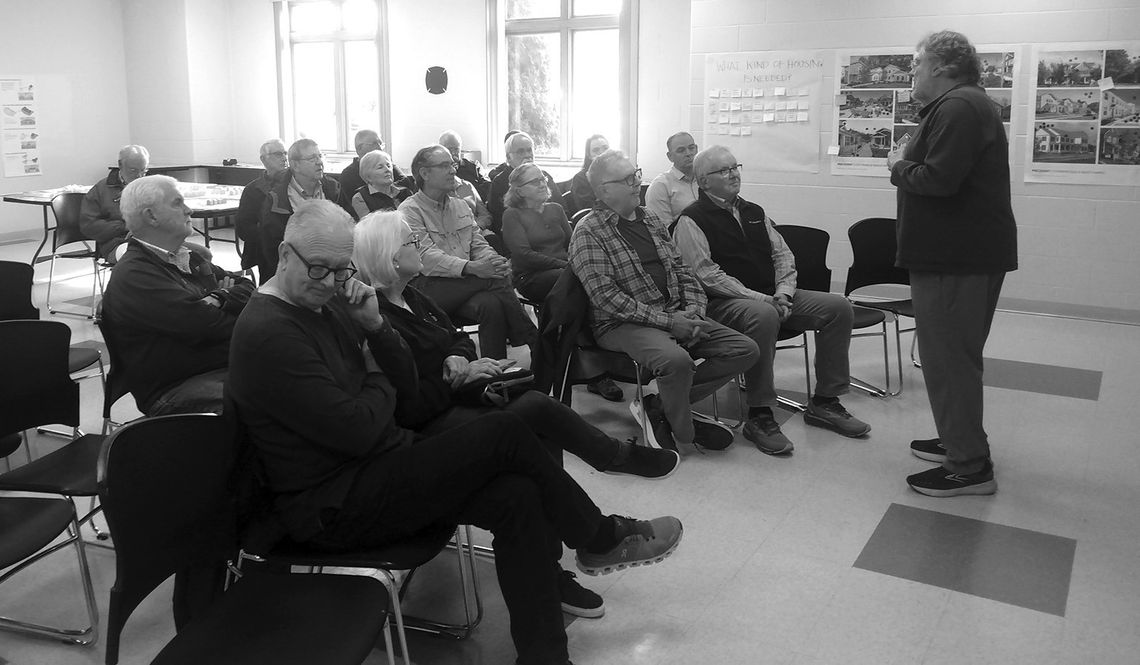Peninsula Housing, a nonprofi t housing land trust, is looking to bring affordable housing to several locations in central Leelanau County. As part of this process, Peninsula Housing’s founder and president, Larry Mawby, hosted a May 2 community workshop at the fire station in Suttons Bay, where he hoped to hear from the community on how best to meet their housing needs.
“There is a real need for housing that is affordable for people working in the community,” Mawby said following after Thursday’s workshop. “Any time we talk to anyone, we really hear the urgency of the need.”
The nonprofit organization seeks to develop affordable housing at two locations in Suttons Bay: a 10-acre farmstead and a neighboring parcel on Herman Road in the township, and another parcel north of the intersection of Fourth Street and St. Mary’s Avenue in the village.
As a community land trust, Peninsula Housing would sell the homes on these parcels for less than their appraised value while retaining ownership of the land. They would then lease the land to the homeowners for a “nominal yearly fee.” This model aims to make housing more affordable. The community land trust is also considering renting, and Mawby said that rentals would work similarly.
Peninsula Housing is trying to reach people who earn between 80-120% of the Area Median Income. Leelanau County has the top per capita wealth in the state, so these earnings are high at between $86,160 and $129,240 per year. Despite this, people who make this much money still can’t afford most rental and for-sale housing in the county, according to presenters at Thursday’s workshop.
Last year, Peninsula Housing was awarded $50,000 through Michigan’s Rural Readiness Grant program to help plan affordable housing in central Leelanau County. Mawby said that the grant has allowed them to hire Urban Design Associates (UDA) and local design firms to develop a “community-based” plan for housing at these parcels.
Thursday’s workshop was part of Peninsula Housing and UDA’s “listening” process, as they sought input from neighboring property owners, planning commission members, and elected officials that will inform how they develop these properties. After a presentation by Mawby, workshop attendees had the opportunity to tally their votes on various design ideas.
“They would really like to see that in smaller scale buildings,” Mawby said. “They don’t want to see one gigantic apartment building. They would like to see — in the township — two-story buildings that (have) maybe a small footprint, or larger townhouse- style things that are, again, two stories.”
Megan O’Hara, a UDA principal who attended the meeting, explained that UDA was founded 60 years ago in Pittsburgh and focuses on “pair(ing) together attainable housing with preserving and adding to the community character — – not one or the other, but both of those things together.”
The last U.S. Census found that Leelanau County had the highest median home values in the state, and O’Hara argued that Suttons Bay needs more “attainable” housing to strengthen its community. She cited some statistics from a 2023 study by Bowen National Research indicating a large housing gap.
“Leelanau County has a gap of over 2,300 housing units that you currently need at this moment. Less than 0.5% of owner- occupied homes are available for purchase, and the average list price is $975,000, which is shocking. And over 60% of people who work in your county drive outside the county for their housing, so we have a very critical need,” O’Hara said.
While Mawby and O’Hara seem eager to develop affordable housing on these parcels, Mawby said that local zoning ordinances currently don’t allow the single- and multifamily homes and apartments that they want to build.
Mawby said the township planning commission is working on amending its zoning ordinances, although he doubts that the new ordinance will be adopted in time for them to apply for Low Income Housing Tax Credits before the next application deadline in the fall.
Partly as a result, Mawby said he does not expect to begin constructing housing and apartments at the Herman Road properties until fall 2025, with rentals and for-sale homes to be made available in summer 2026 at the earliest.
While township officials and planning commission members have been attending these workshops, village officials and staff have been conspicuously absent. Nonetheless, Mawby said that they will continue to try to work with them to develop the St. Mary’s Avenue location.
Peninsula Housing had requested the village to amend its zoning to facilitate multifamily housing. While these amendments were approved by the planning commission, the village council shot down the amendments both times they came before them last year.
When reviewing the initial proposal in February 2023, council members were concerned about allowing taller buildings in the “welcoming corridor” of the village, as the zoning amendments called for an increase from two-and-a-half to three-story buildings.
Peninsula Housing then submitted a modified proposal that still called for an increase to three stories but agreed to stay within the current parameters for maximum building size and height. The proposed changes were once again denied by the village council in November, however.
Mawby’s presentation on Thursday included 3D renderings of the proposed designs for the housing units. These graphics helped give workshop attendees an idea of what the buildings could look like from a street view, and Mawby sought to show that they wouldn’t obstruct the skyline.
Although he admitted that Peninsula Housing still has a long way to go with the township, village, and county, Mawby said he was “really encouraged by this design workshop. I’m hearing that there’s a lot of enthusiasm and support for this.”








